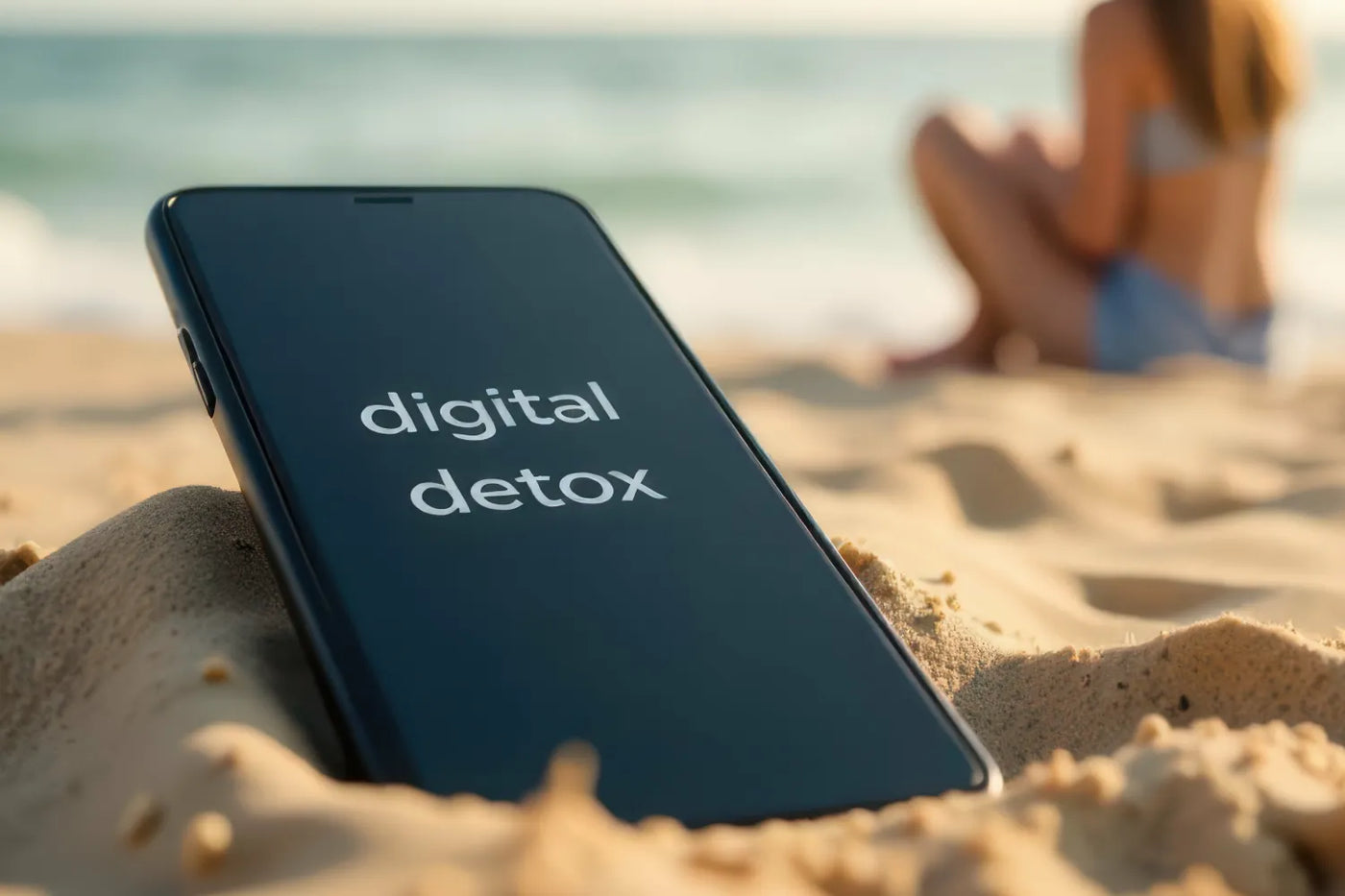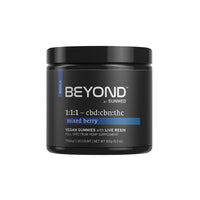7 Tips for a Successful Digital Detox

Key Takeaways:
- A digital detox can help support emotional wellness, better sleep, and sharper focus by reducing overstimulation from screens.
- Even small breaks from digital devices, like screen-free evenings or weekends, can lead to more restful sleep and mental clarity.
- Practices like gentle movement, nature time, and CBD may enhance your detox by helping your body relax and reset.*
Between constant notifications, news updates, and the pressure to stay digitally connected 24/7, it’s easy to feel mentally overloaded.
Many people are turning to digital detoxes as a way to reset. Whether you’re looking for better sleep, more mental clarity, or just a break from the noise, even a short period away from screens can have noticeable effects.
This guide explains the benefits of a digital detox, how to do it sustainably, and how to support your body and mind during the process.
Why try a digital detox?
Spending hours each day scrolling, swiping, and reacting to alerts can have more of an impact than we might realize. Studies show the average adult spends over seven hours a day in front of a screen, and this amount of digital input can affect both mental and physical wellness over time.
Mental strain is one of the biggest reasons people start a digital detox. Exposure to constant information (especially from social media) can lead to overstimulation, comparison, and even emotional burnout. It can also cause changes to the brain.
The brain doesn’t always have time to fully process the stream of content, which can make it harder to concentrate or feel emotionally balanced.
Sleep quality can also be disrupted by screen time, especially in the evening. The blue light emitted from phones and tablets can interfere with the body’s natural production of melatonin, a hormone that helps regulate the sleep cycle.*
On a physical level, hours of scrolling or sitting in front of a computer may contribute to muscle tension in the neck and shoulders, tired eyes, and decreased movement throughout the day. These factors can contribute to feelings of restlessness or fatigue.
A digital detox gives your nervous system a chance to settle and your body a chance to reset. It can help you feel more present and create space for new habits that support relaxation, focus, and emotional clarity.
What are the key benefits of a digital detox?
A digital detox can be a game changer for your mental, physical, and emotional wellbeing.
1. Emotional reset
Taking a break from social media and news alerts allows you to avoid some of the triggers that can contribute to stress or emotional overwhelm.
You may feel a greater sense of calm and control without the pressure to respond, react, or compare. The mind has space to breathe.
2. Mental clarity and focus
Constant exposure to information can make it harder to focus on tasks that require deeper thinking. A digital detox can give your brain time to recover from cognitive overload. Many people report clearer thinking, better decision-making, and more intentional attention after time offline.
3. Improved sleep patterns
Digital stimulation in the evening can interfere with the body’s natural sleep-wake cycle. Taking a break from screens can support your brain's ability to wind down and transition into deeper, more restorative sleep.
Over time, this can lead to better mood, energy, and daytime focus.
4. More meaningful social connection
Unplugging makes it easier to engage fully with people around you. Without distractions, conversations tend to feel more present and connected. A detox can help you build stronger face-to-face relationships and rediscover the value of uninterrupted time with loved ones.
5. Physical relief from screen fatigue
Spending less time on devices gives your body a break. Less eye strain, fewer hunched shoulders, and more opportunities to move throughout the day can all contribute to a more relaxed and refreshed physical state.
Seven tips for a successful digital detox
The idea of unplugging completely can feel overwhelming at first, but it doesn’t have to be all-or-nothing. A digital detox should feel doable, not stressful. These tips can help you ease into the process in a sustainable and supportive way.
1. Start small and build gradually
You don’t need to go offline for a week right away. Start with a single evening, a few screen-free hours, or one unplugged weekend morning. The goal is to reduce your dependence on devices in manageable steps. With time, short detoxes can evolve into longer, more intentional resets.
2. Set clear boundaries
Define when and where screens are off-limits. Common boundaries include no phones in the bedroom, turning off notifications during meals, or designating a daily hour without screens. These clear expectations help train your brain to recognize device-free time as a regular, non-negotiable part of your routine.
3. Use tech to help you unplug
Ironically, your devices can support your detox if used with intention. Try enabling app timers, switching to “do not disturb” mode, or moving distracting apps off your home screen. Some people find grayscale settings (removing color from their screen) make the device feel less stimulating and easier to put down.
4. Design a calm, screen-free environment
Create a space that invites rest. Keep books, journals, herbal tea, or aromatherapy nearby instead of your phone. Consider using an old-school alarm clock or sunrise alarm clock rather than your phone to start your day screen-free.
Replace endless scrolling with soothing activities like stretching, listening to music, or taking a slow walk outside. The more inviting your space feels without screens, the easier it is to commit.
5. Communicate your intentions
Let your friends, family, or coworkers know you’re taking a break. This helps reduce the pressure to respond immediately and allows others to support your choice. Setting up an automatic email reply or turning on focus mode can also reduce the anxiety of being unreachable.
6. Lean into the stillness
It’s common to feel restless at first. You might reach for your phone out of habit, or feel unsure about what to do with extra time. These moments are part of the process. Over time, stillness can become something you look forward to.
7. Refill the time intentionally
A detox creates space, but what you do with that space is what makes the difference. Replace mindless screen time with activities that nurture your wellbeing. This could include meditation, breathwork, creative hobbies, cooking, or simply resting.
These moments can become anchor points that help rewire your relationship with technology.
How to support the body and mind during a detox
Your body responds to digital overload just like it does to any other form of overstimulation — it holds tension, affects sleep, and can impact emotional balance.
Taking a break from screens is a great first step, but you can also support your reset by including wellness practices that help the body unwind and recharge.
Prioritize restorative nutrition and hydration
Fueling your body with nourishing meals helps stabilize energy and support cognitive function. Stay hydrated, especially if you're spending more time outside or being physically active. Balanced nutrition supports your body’s natural recovery processes and can make detox periods feel more grounded.
Move in gentle, mindful ways
When you’re not glued to a screen, you naturally create more room for movement. Walking, stretching, or practicing yoga can help release stored tension in the neck, shoulders, and lower back. Movement is also one of the most effective ways to reset your nervous system.
Reconnect with nature
Being in nature has been linked to lower cortisol levels, improved attention, and emotional wellness. Whether it’s sitting in the sun, walking in a local park, or tending to houseplants, time with natural elements can offer powerful mental refreshment.
Consider adding CBD for relaxation and reset
Hemp-derived CBD may support the body’s ability to unwind by interacting with the endocannabinoid system (ECS), a network of receptors involved in mood, stress response, and rest.*
During a digital detox, CBD can complement calming routines by helping promote a sense of ease and balance.
Some people prefer fast-acting formats like water-soluble CBD during the day to support focus and emotional clarity, while others use gummies or tinctures in the evening to help ease into restful sleep. Look for blends that include naturally calming ingredients like chamomile, lemon balm, or specific indica-leaning terpene profiles for extra support.
Always choose high-quality, third-party tested products, and follow the recommended serving size for best results.
How to know your digital detox is working
It’s easy to assume a digital detox has to be extreme to be effective, but small changes often bring the most noticeable results. As you begin to limit screen time and reconnect with more grounding habits, your body and mind will respond.
You might notice you’re less reactive to everyday stressors or feel more mentally refreshed in the mornings. Many people report that they sleep more soundly after a few evenings without screens. You may also find that you’re more present in conversations, less rushed throughout the day, and more intentional with your time.
Another sign your detox is working is that you stop craving your devices as often. Instead of reaching for your phone out of habit, you start turning to quieter, more restorative routines. This shift can be gradual, but it’s often one of the most powerful outcomes of taking time offline.
Make digital detox a long-term habit
The goal isn’t to eliminate technology altogether, but to build a more thoughtful relationship with it.
You might choose to create screen-free hours in the evening, schedule offline weekends once a month, or take short digital breaks during the workday. Over time, these small adjustments can help reduce feelings of tension and bring more clarity and ease to your everyday life.
Consider using what you learn during a detox to reshape your digital habits long term. You’ll begin to recognize which types of screen time feel purposeful and which types leave you feeling drained.
With consistent boundaries and supportive wellness tools, it becomes easier to stay grounded, focused, and calm.
The bottom line
At Sunmed, we believe wellness is about creating space for your mind and body to thrive. A digital detox is one of the most accessible ways to support emotional wellness, focus, and sleep quality. It gives your system time to slow down, recalibrate, and reconnect with what matters.
Our CBD products are designed to complement that process. Whether you’re unplugging for a weekend or just looking to wind down at the end of the day, our functional, hemp-derived formulas are here to support your reset. With calming blends, naturally soothing terpenes, and formats that fit your lifestyle, like gummies, tinctures, and water-soluble options, we’re here to help you find your calm and make wellness more approachable, every day.
*This statement has not been evaluated by the Food & Drug Administration. This product is not intended to diagnose, treat, cure, or prevent any disease.
FAQs
How does a digital detox improve well-being?
A detox helps reduce mental clutter, support emotional balance, and improve sleep by giving your nervous system a break from constant stimulation. Even short breaks can help you feel more focused, calm, and in control.
What should I do during a digital detox?
Fill your time with calming, screen-free activities like reading, walking, journaling, stretching, or cooking. The goal is to reconnect with your body, your thoughts, and the present moment.
Can CBD help during a digital detox?
Yes, CBD may promote a relaxed mood, support better sleep, and help ease mental tension during a detox by interacting with the body’s endocannabinoid system.*
What should I avoid during a digital detox?
Try not to replace screen time with other overstimulating habits, like multitasking, constant background noise, or excessive caffeine. The goal is to allow your body and mind to reset, so focus on stillness, nourishment, and routines that feel calming and intentional.
Sources:
Alarming Average Screen Time Statistics (2025) | Exploding Topics
What Excessive Screen Time Does to the Adult Brain | Cognitive Enhancement










